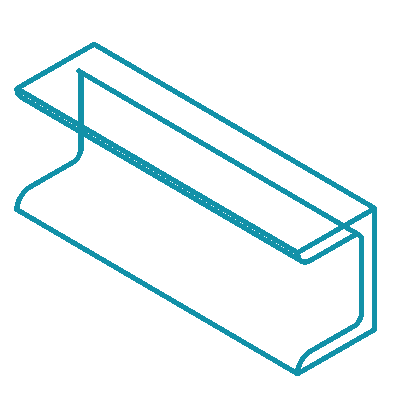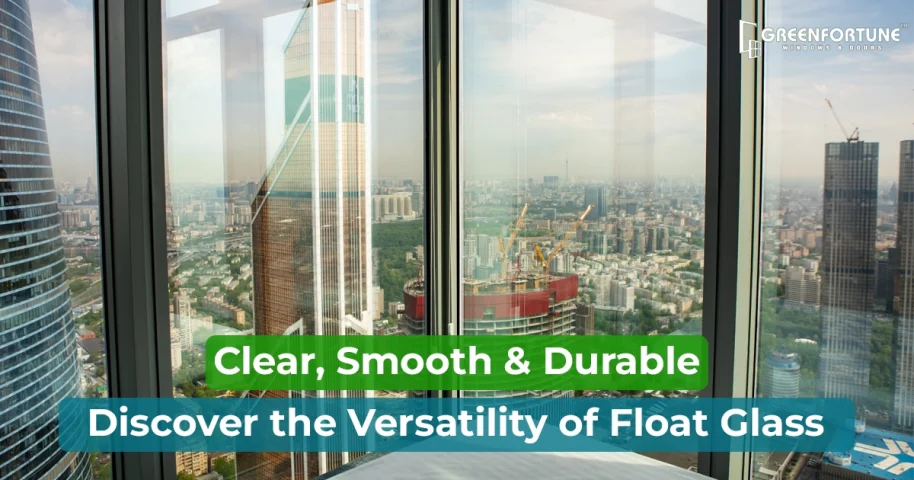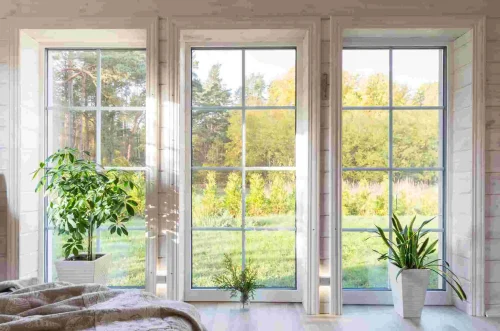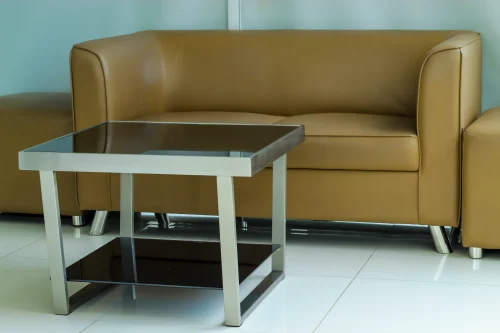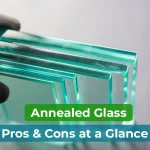
What is Annealed Glass? Pros & Cons
April 1, 2025
How Flooring Glass Design Can Change Your Space
April 2, 2025When we talk about the glass used in modern buildings, cars, and furniture, floating glass is one of the most prevalent types. Float glass has revolutionized how we design structures and everyday objects, offering a smooth, optically transparent surface.
But what exactly is float glass, and why is it so widely used? In this post, we’ll dive into what floating glass is, its production process, applications, and the advantages and drawbacks you need to know.
Table of contents
- What is Floating Glass?
- The Float Glass Production Process
- Applications of Floating Glass
- Advantages of Floating Glass
- Disadvantages of Floating Glass
- Float Glass Thickness and Common Uses
- Float Glass vs Other Types of Glass
- Floating Glass vs Toughened Glass
- Conclusion
- Upgrade Your Space with Green Fortune’s Sustainable Products
- FAQs
What is Floating Glass?
Floating glass, also known as float glass, is a type of flat glass produced through a process that involves floating molten glass on a bed of molten tin. This method ensures the glass surface is incredibly smooth and perfectly even, without the need for grinding or polishing. The float process was invented in the 1950s and has become the dominant method of flat glass production worldwide.
With its perfect flatness and clarity, float glass is used in everything from windows and mirrors to tabletops and automotive windshields. Its most common form is clear float glass, which is widely utilized in architectural applications because of its high transparency.
The Float Glass Production Process
The production of float glass involves several stages, all designed to ensure the final product is flawless and uniform in thickness. Let’s break it down:
- Raw Material Melting: A mixture of sand, soda ash, dolomite, limestone, and other materials is heated in a furnace at approximately 1,600°C. The result is molten glass.
- Floating on Molten Tin: The molten glass is poured onto a bath of molten tin. Since tin has a higher density than glass, the molten glass floats on top of it and spreads out evenly to form a smooth sheet.
- Controlled Cooling: The glass sheet is gradually cooled through an annealing process, which relieves internal stresses and prevents warping or cracking.
- Cutting & Processing: Once the glass is cooled, it’s cut into large sheets and can be further processed (tempering, laminating, etc.) depending on its intended use.
The end product is a high-quality, optically clear glass that can be used in various applications.
Applications of Floating Glass
Float glass is used in a wide range of industries and applications, owing to its versatility, affordability, and optical properties. Below are some common uses of float glass:
- Windows: Whether in residential or commercial buildings, float glass is the standard material for window panes due to its clarity and ability to let in natural light.
- Mirrors: Float glass is often turned into mirrors by applying a reflective coating to the back of the glass. The perfectly smooth surface makes it ideal for this purpose.
- Automotive Windshields: Automotive windshields are commonly made of laminated float glass, which enhances both clarity and safety.
- Glass Facades: Float glass panes are widely used in modern architecture to create sleek, transparent building facades.
Furniture: From glass tabletops to display cases, float glass is used in furniture design for its elegant and modern appearance.
Advantages of Floating Glass
- High Clarity and Transparency: Float glass is prized for its optical clarity. It allows for maximum light transmission, making it ideal for windows, doors, and glass facades where transparency is crucial.
- Smooth Surface: The float process ensures that the glass surface is completely smooth and free from distortions, ripples, or imperfections. This makes it perfect for use in mirrors and display cases.
- Cost-Effective: Float glass is relatively inexpensive to produce, especially in large quantities. This cost-effectiveness makes it one of the most widely used materials in construction and design.
Versatile Applications: Float glass is used in various sectors, including construction, automotive, and furniture. It can also be further processed into laminated or tempered glass, expanding its use in safety applications.
Disadvantages of Floating Glass
- Brittle and Fragile: Standard float glass is relatively brittle and can easily shatter upon impact. When it breaks, it forms sharp, dangerous shards, which can pose safety risks in some applications.
- Limited Thermal Insulation: Float glass doesn't offer much in the way of thermal insulation. In colder climates, double-glazed or coated float glass may be necessary to improve energy efficiency.
- UV Transmission: Regular float glass doesn't block ultraviolet (UV) rays, which means interiors could be exposed to sunlight that causes fading of furniture and fabrics.
Not Ideal for Safety Applications: For high-traffic areas or applications where safety is crucial, tempered or laminated glass is preferred over standard float glass due to its fragility.
Float Glass Thickness and Common Uses
The thickness of float glass clear is a crucial factor that determines its application. Different thicknesses serve various purposes:
Application | Thickness |
Residential Windows | 3mm - 6mm |
Commercial Windows | 6mm - 10mm |
Automotive Windshields | 6mm – 10mm (laminated) |
Shower Doors | 6mm – 12mm (tempered) |
Glass Tabletops | 8mm - 12mm |
For most residential windows, 3-6mm glass is sufficient. However, thicker glass is necessary for applications like glass doors, tabletops, and commercial buildings, where additional strength is required.
Float Glass vs Other Types of Glass
Float glass is often compared to other types of glass, such as toughened glass and laminated glass. Here’s how they differ:
Glass Type | Strength | Safety | Applications |
Float Glass | Standard strength | Breaks into sharp pieces | Windows, mirrors, furniture |
Tempered Glass | 4-5 times stronger than float glass | Breaks into small, safe pieces | Shower doors, automotive windows |
Laminated Glass | Layers of glass with plastic interlayer | Holds together when broken | Safety glass, windshields, security glass |
As seen in the table, float glass has limited strength compared to toughened glass, which is processed to be much more durable. Laminated glass adds a layer of safety by incorporating a plastic interlayer that holds the glass together when shattered.
Floating Glass vs Toughened Glass
Although floating glass is highly versatile, it is not as strong as toughened glass, which undergoes an additional heat treatment process to increase its strength. Toughened glass, often used in high-impact environments like doors, railings, and shower enclosures, is up to five times stronger than standard float glass.
- Toughened Glass Door: More suitable for high-traffic areas, as it is less likely to break or shatter.
- Toughened Glass Thickness: Typically ranges from 6mm to 12mm, depending on the application. For higher safety requirements, thicker toughened glass is recommended.
Conclusion
Floating glass is a versatile, affordable, and widely used material in industries like construction, automotive, and furniture design. Its high clarity, smooth surface, and adaptability make it ideal for a range of applications. However, it has its limitations, such as fragility and lack of UV protection. By understanding its pros and cons, you can make more informed decisions when choosing the right type of glass for your projects.
Upgrade Your Space with Green Fortune’s Sustainable Products
At Green Fortune, we provide top-tier windows, doors, and facade systems designed for energy efficiency, durability, and style. Our product line includes uPVC and aluminum windows and doors, offering premium solutions for modern homes and commercial spaces.
Enhance your interiors with sleek designs while improving insulation and security. Explore our range today and invest in high-quality windows and doors that elevate your space’s aesthetics and performance.
FAQs
1. What is floating glass mainly used for?
Floating glass is widely used in windows, doors, mirrors, and furniture due to its high clarity and smooth surface. It also serves as the base material for laminated or tempered glass.
2. Is floating glass safe for shower enclosures?
Standard float glass is not ideal for shower enclosures due to its fragility. However, tempered float glass, which is much stronger, is a safe option for showers.
3. What are the advantages of using float glass in construction?
Float glass offers excellent optical clarity, allowing maximum light transmission, which makes it ideal for large windows and facades. Additionally, it can be easily cut, polished, or coated, making it versatile for various construction applications.
4. Can float glass be recycled?
Yes, float glass is 100% recyclable. Recycled float glass can be melted down and reused in the production of new glass, making it a sustainable option.
5. How thick should float glass be for windows?
For residential windows, float glass is typically 3-6mm thick. For commercial applications or areas where durability is crucial, thicker glass (6-10mm) is often used.


